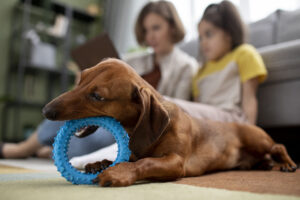Getting a new puppy is an exciting and adorable experience, but it also comes with its fair share of challenges, one of which is teething.
Just like human babies, puppies go through a teething phase where their baby teeth are replaced with their adult teeth. This process can be frustrating for pet owners. Let’s explore the different stages of puppy teething, understand why puppies chew, and learn some effective strategies to manage this behaviour.
 Teething Stages:
Teething Stages:
Puppies begin their tooth eruption journey at around two to three weeks of age when their incisors start to appear. These are the front teeth, and by six weeks, they will have six incisors on both the top and bottom jaws.
At four weeks of age, the needle-like canines start to emerge, one on each side of the incisors, both on the top and bottom jaw.
Between three to six weeks, premolars and molars begin to grow behind the canines. On each side, there will be three premolars and three molars on the top and bottom.
By six to eight weeks, the last molars come in, usually when the puppy is ready to leave for its new home. During this time, the permanent teeth will push out the milk teeth, with an additional 14 teeth coming in. Interestingly, the body reabsorbs the roots of the baby teeth as they fall out.
The entire teething process lasts until around 6 to 7 months of age, during which all 42 teeth will have come in. Teething typically peaks between 12 to 16 weeks, which is when biting behaviour is most intense. It’s essential to remember that puppies don’t all develop at the same rate, and different breeds may have slightly different tooth eruption timelines.
 Why Puppies Chew:
Why Puppies Chew:
Teething in puppies is entirely normal, just as it is in human children. However, unlike human babies, puppies often get a bad rap for their chewing behaviour. Puppies explore the world around them using their mouths, and teething intensifies this behaviour. It’s essential to understand that this is a natural part of their development.
Additionally, puppies mouth and bite as a way of learning, and this can sometimes include humans and other animals. A puppy with it’s littermates might initiate play by nipping their sibling. If the puppy nipped their sibling too hard, the sibling would yelp, providing feedback to the puppy that their nip was painful. Some trainers still suggest owners give out a high pitched yelp as if they were hurt when their puppy nips them. Our view is that yelping actually turns you into a giant squeaky toy for your puppy and may even exaggerate the biting as puppies love squeaky toys!
While this behaviour may seem annoying or even aggressive, it’s crucial to recognise that puppies lack empathy in the same way as human children. Therefore, as pet owners, we need to approach training and behaviour management with patience and understanding.
Managing Puppy Chewing:
Dealing with a teething puppy can be challenging, but it’s vital to handle it positively and effectively. Punishment is not the answer when it comes to curbing chewing behaviours. Instead, focus on managing the puppy and their environment.
Creating a safe and restricted space for your puppy, such as using crates, puppy pens, or puppy confinement areas, can help prevent access to vulnerable or dangerous items. This will not only keep your puppy safe but also make supervision easier. Providing your puppy with appropriate chew toys is essential, as it redirects their chewing instincts to suitable items and will form a habit that will stand them in good stead for life. Hollow rubber chew toys that can be filled with food also reward your puppy for chewing appropriate toys.
Puppy teething is a natural and temporary phase that all dog owners will experience. Understanding the different teething stages and the reasons behind chewing behaviours will help you approach this phase with more patience and empathy. Remember that every puppy is unique, so finding the most effective training methods may require some trial and error. By providing a safe environment and appropriate chew toys, you can help your new puppy navigate this teething phase and set them up for a happy and healthy life.
